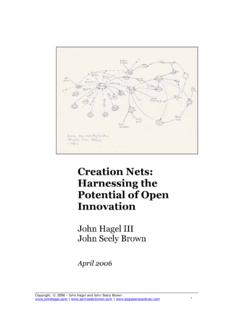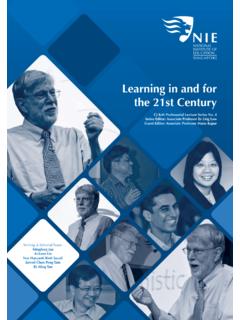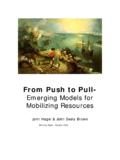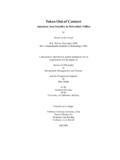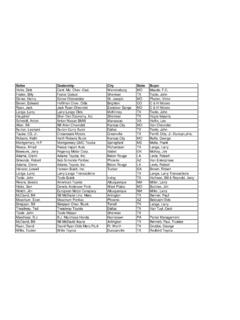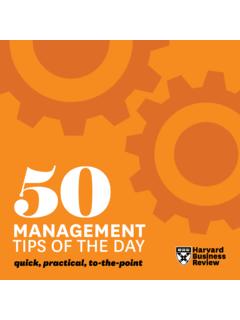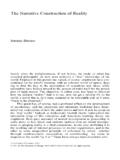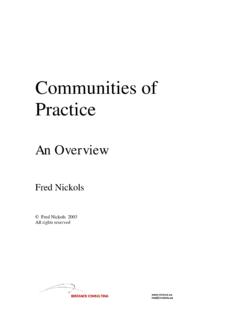Transcription of New Learning Environments final 4 - John Seely Brown
1 New Learning Environments for the 21st Century* john Seely Brown As the pace of change in the 21st century continues to increase, the world is becoming more interconnected and complex, and the knowledge economy is craving more intellectual property. In this environment , it is critical that we shift our focus from education to life-long Learning . Fortunately, the increasing availability of Learning resources on the internet is coinciding with the growing importance of continuous Learning . If we are willing to view Learning from a new perspective, we are no longer resource constrained. Opportunities to enhance Learning by exploring the edge are presenting themselves as well. It is at the edge that most innovation occurs and where we can discern patterns that indicate new kinds of opportunities and challenges.
2 In this context, the edge can mean many things: kids who grow up digital, second-tier and for-profit teaching institutions, developments in rapidly changing nations such as China and India, new kinds of institutional frameworks such as creative commons, open source, and Wikipedia, and new media forms. Each of these relates to another edge the edge of the educational establishment. Because I was brought up as a hard core technologist, I was surprised to find that some of the most innovative uses of technology occur on another edge at least from my perspective- that is, in the humanities. Not the first place I would have looked, but I was wrong. * This paper is based primarily on a presentation by the author at the Forum for the Future of Higher Education s 2005 Aspen Symposium and a shortened version of it is published on their website.
3 2 A New Context for Learning Let s step back a moment and look at the context we all find ourselves in and the challenges we face. First, every one of us recognizes that today s kids, our students, are different from most of us here. They have a new vernacular - a digital vernacular. But today s students also learn in ways that are different from how we learn. How can we begin to take advantage of those differences? Second, one of the most ironic situations is that although education is more important than ever today, the public at least in my home state of California seems less willing to pay for it than ever before. At a minimum we need to find ways to tap the naturally occurring curiosities of our students so that we can turn them loose to do more Learning on their own. Third, if we want to educate students for the 21st century, we must realize that most students today aren t going to have a fixed, single career; instead, they are most likely going to follow a working trajectory that encompasses multiple careers.
4 As they move from career to career, much of what they will need to learn won t be what they learned in school a decade earlier. They will have to be able to pick up new skills outside of today s traditional educational institution. Fourth, since nearly all of the significant problems of tomorrow are likely to be systemic problems problems that can t be addressed by any one specialty -- our students will need to feel comfortable working in cross disciplinary teams that encompass multiple ways of knowing. Fifth, and finally, one of the big challenges we face is how to encourage institutions of higher Learning to become Learning institutions themselves. Some for-profit institutions, such as University of Phoenix, are doing this quite well. Perhaps we need to learn some practices from them. As if these challenges are not enough, let us reflect on Tom Friedman s recent book, The World is Flat, or the book that john Hagel and I also wrote recently, The Only Sustainable Edge, in terms of the challenges we face in a truly global economy.
5 In that regard, consider this astounding piece of data: In 2004, China and India graduated about 500,000 engineers and the United States graduated 90,000 engineers. Moreover, 40,000 of the graduating engineers in the returned home to India and China. The net is 550,000 engineers over there and 50,000 engineers over here. This is a year-over-year growth pattern. In just a few years, then, there will be millions of more technically educated people in China and India than in this country. Further, if you have a conversation with students in either India or China you can t help but be impressed with their passion to learn and the energy they bring to this pursuit. Let us hope we can find ways to unleash a similar level of passion in our students to learn, learn and learn. 3 New Learning Models Might there be a way to re-conceptualize parts of our educational system and at the same time find ways to reinforce Learning outside of formal schooling so that these challenges can be met in a cost effective way?
6 Successful models of Learning already in place offer ideas that may be more broadly applied. Let s start with the training of architects, done mostly in studios. Note that in studio-based Learning Environments all work-in-progress is always made public. As a result, every student can see what every other student is doing. Moreover, every student witnesses the thinking processes that other students are using to develop their designs. And then there is the public crit. What typically happens is that the master and several outside practitioners come in and critique each of the student s projects. The other students not only get to hear each other s critiques, but because they were in some sense peripheral participants in the evolution of each other s work, they understanding the thinking behind it. They have a moderately nuanced understanding of the design choices, the constraints, the unintended consequences of choices made early on, and the compromises that may underlay the final product.
7 As a result, the brief crit holds substantial significance and presents Learning opportunities for all the students not just the one whose project is being critiqued. Now compare the efficiency of the professor s time in this situation with the time typically spent talking with students during office hours. Also consider how students in studios start to pick up skills from each other, , how they witness the wide variety of ways to approach a design problem in the first place and how they start to appreciate and learn from the struggles, the missteps, and the successes of their peers, as well as how they start to learn the social and intellectual practices that enable them as an 4ensemble to become a reflective practicum. Indeed, they are starting to be enculturated into the practice of being an architect.
8 Learning as enculturation is a side of Learning seldom discussed except by social Learning theorists a school of thought I will come back to. You may be thinking, yes, but studios are studios. How many students are in a studio at any one time? How does this scale? If we can t actually figure out interesting teaching or Learning innovations that scale, then forget it. But studio-based Learning can scale. Let me show you one more example - a very interesting example from the Massachusetts Institute of Technology (MIT). This is the Technology Enabled Active Learning (TEAL) project at MIT. I believe this idea was borrowed from Rochester Polytechnic Institute and extended by Professor john Blecher at MIT. The particular stimulus that led Professor Belcher to construct a studio-based approach to physics stemmed from MIT s experience with its Electricity and Magnetism (E&M) course.
9 This course used to be a wonderful course for convincing most students who thought they wanted to become physicists or engineers that the grass may be greener elsewhere. The attrition rate was very high; the attendance rate was low. In other words, this course was a buster. So Professor Belcher set out to build a studio for Learning electricity and magnetism a bold move considering how theoretical this subject matter tends to be. It is not a field that lends itself to intuitive causal or mental models. Instead, it is a subject that traffics in field equations expressed as partial differential equations. And so MIT built a new kind of classroom for studio based Learning of E&M. The classroom consists of 13 tables with nine students per table. Most of the student work involves building, running and experimenting with simulation models pertinent to E&M and then solving problems.
10 No traditional lecturing takes place. Yes, a small amount of 5recitation goes on, but mostly the professor and teaching assistants walk around from table to table, see what interesting issues are unfolding, and occasionally interrupt the entire studio to discuss something that a particular table is encountering. To many of us, this seemed like a wonderful idea. It worked fairly well, but not as well as Belcher had hoped. So after the second year, Belcher and his team decided to step back and reflect on what was really going on. They began to realize that while they were all skilled at lecturing to 800 people in massive lecture halls, perhaps the practices that worked so well in the lecture hall were counter-productive for a studio-based Learning environment . Maybe new teaching practices tuned to this new kind of Learning environment were needed.
